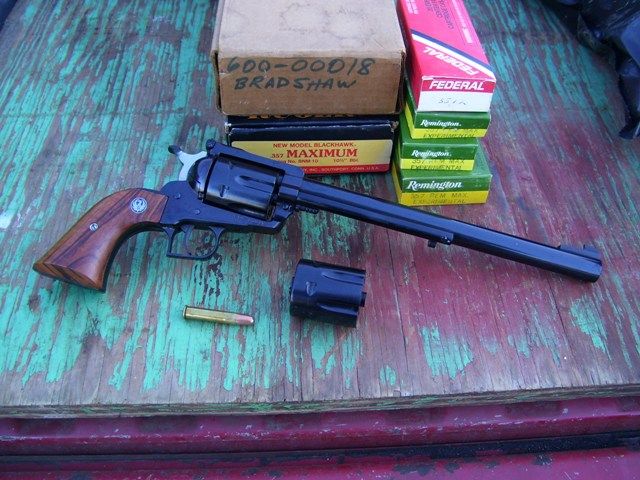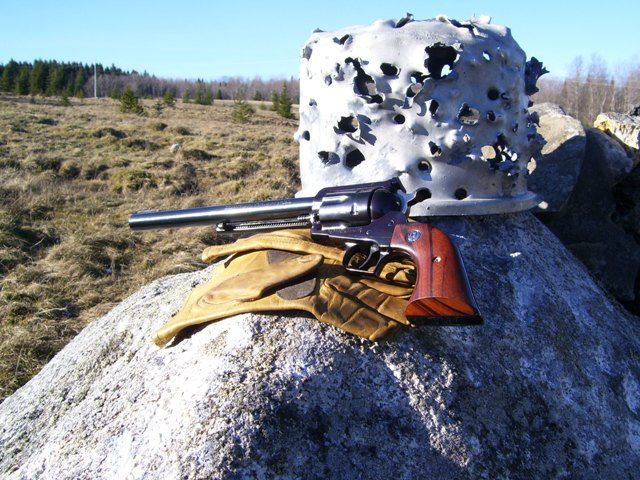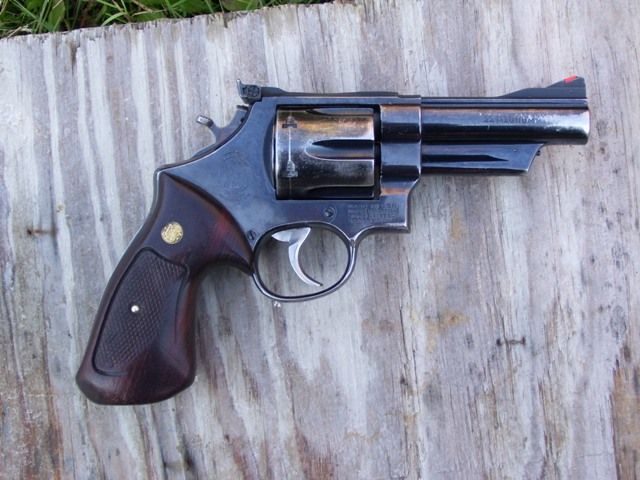|
|
Post by Lee Martin on Dec 8, 2012 15:56:11 GMT -5
David Bradshaw asked me to post these on his behalf: The first production 357 Maximum Ruger:  What David did to a spaghetti pot at 200 yards:  S&W 29-2 blue 4" .44 mag. Hammer, trigger, grip modified by Bradshaw. Action tuned, barrel set back (forcing cone erosion) by S&W factory master Al Plaas  S&W 29-2 nickel 8-3/8" .44 mag. Water molded Frenchback holster with elk lacing by David Bradshaw  Hopefully David will chime in with more details. -Lee www.singleactions.com"Building carpal tunnel one round at a time" |
|
jwp475
.375 Atomic
  
Posts: 1,101
|
Post by jwp475 on Dec 8, 2012 19:57:33 GMT -5
David Bradshaw is one of the all time great shots that ever lived IMHO. David could clean a bank of rams at 200 meters with a 1911 45 ACP
|
|
|
|
Post by Lee Martin on Dec 8, 2012 22:40:51 GMT -5
I couldn't agree more John. We're fortunate to have David as a member and the sport needs more like him. Even more impressive than his skill is the fact he's an absolute straight shooter (pun intended). He's a wealth of knowledge and I hope he'll post often. -Lee www.sngleactions.com"Building carpal tunnel one round at a time" |
|
akray
.30 Stingray
 "Alaska is what the Wild West was"
"Alaska is what the Wild West was"
Posts: 388
|
Post by akray on Dec 10, 2012 3:37:13 GMT -5
The 4" 29-2 also has a Millett or some other aftermarket sight on it. I like how he values shooting ability over keeping his revolver in 95% or better condition. Collectors put on gloves and are so careful with how they treat their guns. This one's been used for its intended purpose. I hope the gun means something more to the family down the line because it's ridden so many miles on Mr. Bradshaw's hip.
|
|
|
|
Post by bradshaw on Dec 11, 2012 13:55:01 GMT -5
Akray, you are correct, that is a Millett rear sight on the 4-inch 29. I put it on following an altercation, during which I had to quell a man intent on harm. During the tussle, unbeknownst to me at the time, my revolver came out the thumb break holster. It had hit the floor, probably hard, and slid under the cigarette machine. When I retrieved it, the rear sight blade was broken. Don't remember whether I noticed the broken slide then or later.
The "slide" or blade was cracked right through, not bent over, which tells me the slide is pretty hard, not soft. Under the circumstances the S&W sight passed muster, as there was no damage otherwise.
I took the opportunity to try the Millett sight, which I came to like very well for its adjustments and clean picture. Fortunately, I haven't had to put the Millett through the "Smith & Wesson test."
Al Plaas (sp?) was a very cool, old school guru on Smith & Wesson revolvers. He worked on a number of my guns at the factory, and I cherish watching him at work. Musical hands.
That little M-29 fed a lot of people, but that is another story.
David Bradshaw
|
|
|
|
Post by Lee Martin on Dec 11, 2012 16:15:35 GMT -5
I'll let David tell it, but there's a neat story surrounding the Maximum and its gripframe (or intended gripframe). -Lee www.singleactions.com"Building carpal tunnel one round at a time" |
|
sixer
.240 Incinerator

Posts: 78
|
Post by sixer on Dec 11, 2012 18:18:07 GMT -5
I now count two stories being alluded to. Hell, I would love to hear both of them.
|
|
|
|
Post by Seasons44 on Dec 11, 2012 22:51:43 GMT -5
Wow, great photos , would love listen to stories for hours, thank you for sharing!
|
|
|
|
Post by bradshaw on Dec 12, 2012 20:57:33 GMT -5
Snowy cold raw day. Spaghetti pot barely visible on the granite boulder. Aluminum and snow look alike under gray sky. Raise rear sight one click with thumbnail, as my only chance of seeing the spaghetti pot is to lower sight picture a hair. Ear back hammer on the .357 Maximum.
Tiny target out there pulls eye downrange, off front sight. To keep target from disappearing, brain clamps landscape to target. The eye sketches the rear sight to obey the front.
The front sight polishes the trigger.
BOOM!----TINK! Pot jolts straight back, off rock. At 200 yards, this is a Maximum at work, a bit of deliverance.
David Bradshaw
|
|
akray
.30 Stingray
 "Alaska is what the Wild West was"
"Alaska is what the Wild West was"
Posts: 388
|
Post by akray on Dec 13, 2012 3:17:03 GMT -5
Bob Milek recommended the Millett rear sight for the S&W Mod. 29 in his writings. He wrote that the "rear sight blade sits so high above the gun that it takes every knock in the field" or words to that effect. I stuck with the factory sights on my gun, but did replace the factory targets with Herrett's Shooting Star grips. I went to Pachmayrs next, then some aftermarket fingergroove grips I got somewhere. It's hard to find a set of grips for an N Frame that fit your hand correctly.
|
|
|
|
Post by bradshaw on Dec 13, 2012 15:45:40 GMT -5
akray.... how right you are. I've had all sorts of grips on Model 29's. The two best for my hand, one of 'em on the 29-2 4" pictured above; the other also my rework of the factory "Goncalo Alves." I'll try to get a photo of the 29-2 6-1/2" up soon. (I'm a caveman at this game.)
S&W has made their "target" or magnum stock, in various permutations, some horrible. On a double action revolver, the middle finger is a load-bearing finger. It holds weight. The grip must curve to meet the trigger guard on the tangent. To run the grip straight into the middle of the trigger guard exposes the middle finger to punishment. I need a radius, a middle finger groove, to separate the middle finger from the bow and protect it from recoil.
Besides controlling recoil, the grip must receive your hand the same way every time you draw.
David Bradshaw
|
|
|
|
Post by tullymars on Dec 13, 2012 22:00:05 GMT -5
Mr. Bradshaw, let me say that I love the looks of your working guns. I've been following some of your responses on other topics on this forum and am enjoying learning from you. I hope you like it here.
|
|
|
|
Post by jayhawker on Dec 14, 2012 1:21:24 GMT -5
One of the great movie Fast Draw coaches, Rodd Redwing, advised short practise sessions. Once one starts to tire, they unconciously change the way they are doing something. To continue after that is to reinforce doing it the wrong way.
|
|
|
|
Post by jayhawker on Dec 14, 2012 1:23:15 GMT -5
OOps, the above should have been on the next thread.
|
|
|
|
Post by bradshaw on Dec 15, 2012 12:24:33 GMT -5
Tried various grips on the 4" M-29 over the years; kept coming back to the original stocks, reworked. The bobbed hammer followed my experience with my first M-29, the all-around 6-1/2-inch, with an S&W charcoal blue so fine it is hard to believe the mileage on that gun. A homemade form fitting, water-molded holster of finest oil-tanned English saddle leather helps, as there is no slop-wear of inferior leather on the gun.
That old 6-1/2" 29 has the original beavertail hammer spur and wide serrated trigger, which match the revolver perfectly. However, the aggressive checkering on the beavertail spur chewed the lining of hunting coats, including a green & black wool coat from Johnson's Woolen Mills in Vermont. Heavy flannel reinforcement fixed the Johnson coat. Despite damage to the coat lining, the original M-29 hammer belongs on the 6-1/2".
The original beavertail on the 4" is too much. It is obtrusive for waist-carry. So I took out the hammer and ground off half the length of the spur, preserving the width, which is better than going to the M&P style Model 28 hammer.
Narrowed the wide trigger, rounded it, leaving a very low radius on the front, which I prefer to the full-round radius of some custom jobs.
Left a trace of serration lines at the top, a signature to prove the origin of the trigger. No less than top S&W factory smith Al Plaas said, "I'm changing some of the guts, along with cylinder pin and extractor rod, but your hammer and trigger are fine."
I think Al Plaas retired before the advent of non-forged innards.
David Bradshaw
|
|